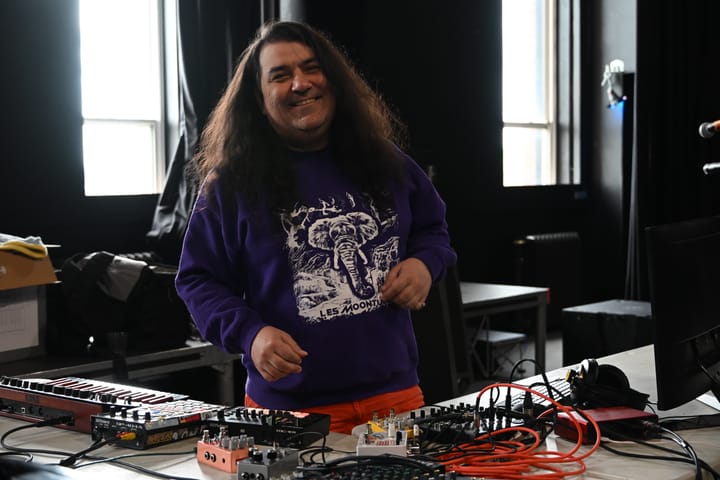
Deep Digs: Breach Of Trust - Songs For Dying Nations (2000)
This article is part of New Feeling's Deep Digs – a series we take a look at significant albums from Canadian history, with an emphasis on music that might have been overlooked the first time around.
One day, in my early years as a young rock musician, I happened upon a video for a song called “Complicated” by a band I had never heard of called Breach of Trust. Though I was living in Canada when they were at their most active, I had never heard of them. I didn’t really see many non-white performers in this country making this kind of music when I was a child, and certainly not the highly aggressive kind that the band played. Their music had an urgency to it and spoke from a point of view that I could relate to as a BIPOC in a society that did not care for me; and as a Jamaican who has lived with the results of colonial oppression. It was music that even now sticks with me. Why hadn’t I heard of them before? Why didn't they become a much bigger force in Canadian rock music? These were questions I sought to answer as I began researching as much as I could about the band. My search led me to learning about not only the band but also to learn about their album Songs For Dying Nations, an important yet highly underappreciated record.
The album is a touchstone collection of songs from a band who were, and in many ways still are, an anomaly in Canadian music. They were an all-Indigenous band that had managed to scratch the surface of mainstream attention while being an unambiguous rock band that avoided the usual stereotypes associated with “Indigenous” music and musicians.Indigenous art is rarely expected to be modern in any kind of way, from the clothing the musicians wear, to the style of music that they play, which are assumed to be rooted in a kind of timeless "tradition," even though those traditions are highly stigmatized and often policed by settlers. Breach of Trust was notably bucking many of those standards without bringing attention to them. They represented, in some ways, a side of First Nations culture that was not frequently given attention by Canadian media. Their emergence would coincide with a broader global movement that has been called "The Indigenous New Wave of film” which saw Indigenous filmmakers from around the world challenge popular ideas about their cultures and create media that represented their modern experiences.
The expectations placed on musicians like Breach of Trust often make the contributions of Indigenous people and their music invisible. This is particularly true in the case of rock music; from blues pioneer Charlie Patton, to early rock and roll proto-punk Link Wray, and singer Joey Belladonna of the band Anthrax. Despite this, Indigenous musicians are typically all grouped together, regardless of whether they're First Nation, Metis, or Inuit, and without much attention paid to the type of music they might actually be making when thought of in the public imagination, similar to the “Urban” categorization of Black music. This othering is seen everywhere from radio programing to award categories.
The La Ronge, Saskatchewan band started out in the early 90s as a cover band called The Ugly Sisters by Cree singer/guitarist Marty Ballentyne and Cherokee drummer William Aubut, and later rounded out by Metis bassist Zane Kryzanowsky and guitarist Darryl Lavallee, or as Ballentyne eloquently put it, “the best guys in the north." Their initial beginning as a cover band was a reaction to the somewhat shaky reception of Ballenyne and Aubut’s previous experimental band The Hair Farmers in the late 80s. “We'd jam like war pigs by Sabbath, Faith No More, In Living Color, and The Chili Peppers and all this stuff before it was really popular,” Ballentyne reminisces, speaking about his time in the Hair Farmers in an unpublished interview I did with him in 2021.
“Late eighties, early nineties, nobody in northern Saskatchewan wanted to hear anything about that kind of music, but they liked us.” Not long after the start of the Ugly Sisters, the band would begin playing original music with a mindset that Ballentyne describes as “we're gonna do it better than anybody.” After a small member change where Lavallee left and was replaced on guitar and screaming vocals by Colin “Cheech” Cheechoo (who is the son of Cree folk singer Vern Cheechoo) the classic line-up of the band would solidify, with their work as a cover band allowing them to build up funds for future recordings and equipment for original material.
Speaking with Ballentyne about this early period, it is clear that while it is largely ignored by the broader Canadian musical landscape, the northern regions of the Western Canadian provinces are home to a thriving network of musicians, venues, and local scenes. Balleyne, who had cut his teeth in those scenes, regails me with many stories, including an anecdote about receiving a large payout consisting of a bag of loonies and toonies after a show in northern Manitoba. “We had a bunch of great experiences up north,”Ballentyne remembers with a smile, “and so many of the people that supported us up north became a big part of the core Breach Of Trust fan base too."
After some time spent developing their sound and writing songs, the band would release the Dead Issue EP in 95. A five-song effort that showcases the young band bursting at the seams with ideas and energy whose standout track, the alt-metal meets 90s indie rock, “Family” would prove to be a hint of their future sound and lyricall bite. They would then record and self-release Songs For Dying Nations a few years later using both the money they had saved up from their cover band as well funds gathered from various funding bodies. The album garnered attention from both the Canadian and US music scenes, along with a video for the song “Who Am I." “Labels started coming to the gigs,” Ballentyne explains, “through the summer and fall of 2000, that's where it really kind of caught national awareness.” This attention would lead to the band signing to EMI who would re-release the album with wider distribution.
The band was not alone in the late 90s and early 00s as Staggered Crossing was a contemporary of the group whose lead singer and guitar player Julian Taylor is of mixed Afro-Caribbean and Mohawk ancestry as was all girl pop-punk group LiveOnRelase was fronted by Metis Singer Colette Trudeau. Both bands courted mainstream attention while Cree singer Eden Fine Day fronted Vancougar which garnered underground respect. A common element shared by these bands was that the Indigenous backgrounds of their front persons were not at the forefront and could in some ways be missed entirely on first glance by the inattentive listener or journalist. Breach of Trust was similar yet different in that, while they never explicitly put their Indigeneity forward in ways that would be “conventional” to a white Canadian audience, their status as an all Indigenous band was central to their music and image. For a time, they even wanted to go with the name, “AKA Genocide,” but it was already taken by another band.
The background of the band and in particular that of singer and lyricist Marty Ballentyne, is infused into every facet of the album from the songs themselves to the cover art and album name. Inspired by the culturally and community focused themes groups like Minor Threat and Bad Brains would explore in their music, the band sought out to create an album both reflective of their roots and of their experiences. This is music that is created by talented First Nations individuals who have chosen to express themselves through the power of rock music with lyrics that express their concerns, their hope, their sorrow, their joy, and, over the course of the album, their rage. “I just realized that I could draw upon our Indigenous backgrounds and put that into the music and present that in a way that hadn't been presented by anybody that I'd seen musically,” Ballentyne explains. “Certainly not the kind of music we wanted to make.”
The album itself is unique in that it is able to capture a band at their most raw and unfiltered while only having just enough polish to keep everything together; creating a strong balance. With Ballentyne being a student of rock, punk, and metal, the band pulls from several places: classic rock, alternative metal, late 80s post-hardcore, and even folk. Lyrically, the songs combine the personal and the political, bringing together stories of inner conflict and human turmoil against the backdrop of settler colonialism and hundreds of years of genocide. The nebulous labels of “post-grunge” and “nu-metal” that have misguidedly been attached to the band do the album and the substance of the music a great disservice .
Some of the songs that best showcase this progressive sound include opener “Disease“ which immediately pummels the listener with riffs and rhythms that almost mimic a winter storm, and with lyrics examining the ways a corrupt society can set people up to fail from the very beginning. “An Offering” stands out as one of the slower and more contemplative songs, with Ballentyne’s vocals showcasing a powerful vulnerability. Lyrically and thematically, the song deals with the concept of home and the longing that a person can have for that home. “I had the idea in my head about writing, about feeling like you're from somewhere and having a connection to the land or the place that you're from,” explains Ballentyne. “It honors where I come from. It honors my background and my teachings, so I felt good about that one."
“Who Am I” is another stand-out track. Sonically, it is a Helmet-esque, near-industrial soundscape that evokes a quiet fury. Lyrically, the song examines the multifaceted nature of identity, in particular that of the band members as Indigenous people in a colonial state, mixed race people, and humans living in an increasingly detached world. Lyrics such as “culture retained, product of the land from which I came” call attention to the historic displacement of Indigenous peoples within the framework of the Canadian state and the ways in which that state has, paradoxically, made a society of memories and joy in a place rooted in trauma. The song is one of the best examples of Ballentyne’s ability to merge the personal and the political through poetic sensibilities and into something that can be appreciated in several layers.
Other highlights include album Closer and third video single “Complicated,” which is one of the most stylistically consistent tracks, artfully using a pixies-esque quiet/loud dynamic to build a tense atmosphere that compliments contemplative lyrics and leads to a vibrant denouement; “Generational” which assaults the listener with a hardcore punk wall of sound with lyrics that tackle the struggles people have in the face of generational trauma, repeating patterns, and historic disenfranchisement; and the groovy post-hardcore musings of “Empty.”
In a period that was marked by numerous conflicts between the Canadian state and the Indigenous peoples that coincided with the complete end of the residential school system, the album acts as a loud yet subtle form of catharsis and protest against the systems that have created the conditions for the group’s rage. Such an outlet was largely absent in the mainstream during that period.
As for why the album has largely been ignored in the decades since, two potential reasons come to mind, the first being the nature of the band as an all-Indigenous rock group during the period. While the band did not experience any direct discrimination from fellow musicians and crowd and they did receive some love from some mainstream music press of the day (such as MuchMusic), as Ballentyne explains to me, the music industry is known for having difficulties promoting musicians that do not fit into certain boxes. Similar to contemporaries Blaxäm who were an all-black band that both avoided stereotypes and played a sonically progressive form of rock, Breach of Trust appeared to face a similar issue of record labels, radio stations, and audiences not fully knowing how to present or conceptualize them. Ballentyne speaks of being labeled and branded: “When we released a record on EMI, one thing I wasn't savvy enough about, media wise, that I got savvy about later was that when we did the press release for Breach of Trust and the introduction with EMI we put in that we were Indigenous,” he explains. “I felt we had to come correct and be who we were and say who we were and not avoid it or push it back.” There were no bands like Breach of Trust at the time in Canadian music, and it is clear that, while they would garner some respect (winning three Indigenous Music awards for “Songs for Dying Nations”) and a core fanbase, the band would experience many barriers. “As supportive as [Much Music] were, you know, like anytime there was an ‘Aboriginal Day’ or something like that, we'd always get called <laugh>.”
The other potential reason is the precarious timing of the release. While it coincided with the major label debuts of various post hardcore groups such as Glassjaw and At the Drive-in, the musical landscape of the era was still dominated by the last vestiges of nu-metal bands, the post Blink-182 pop-punk scene was at its peak, and Nickelback was on the rise. “The label was expecting certain things from us, and there was this weird pressure in the industry because of Nickelback's success,” Ballentyne explains. “And in the early 2000s, they were so successful that for a while there was a pressure, I think, for anybody that was making hard rock music or the sort of music we were making to fit into that kind of mold.” The brand of alt metal, alt rock, and post-hardcore fusion that the band excelled at had yet to have the full-on mainstream breakthrough that Canadian contemporaries Billy Talent, Silverstein, and Alexisonfire would ride to varying levels of success just a few years later. The band was also not tied to the underground scene enough to sit comfortably within the niches carved out by contemporaries Chore, Grade, or the groups from the Western Canadian noise rock scene. The band, while ahead of their time, were effectively sonic outsiders.
Four years later Breach of Trust would release a follow up self titled album that, while a valiant and polished if somewhat underwhelming sophomore effort, failed to build on the success of the previous release. Part of this can be attributed to the unfortunately common issue of labels changing priorities and reallocating resources to other bands. This came to a head in the early part of 2005. “I started calling the label and started getting voicemails. So I leave voicemails and I don't hear back,” Ballentyne explains. “That went on for about six weeks with no response from anybody at the label. Like no calls back, could never get anybody on the phone, could never get a call back." After a long period of waiting for answers and an inability to get information from people at the label, Ballentyne made a direct call toward label head Deane Cameron. “He said to me, ‘there's no enthusiasm at the label for this project anymore’, and that was it”, Ballentyne recounts the final call he made to the label head, “that was it for EMI.” The callous treatment from the label toward the band at the end is indicative of the cold ways in which the music industry operates, especially with regard to BIPOC groups, who are easily pushed to the margins and readily abandoned by the industry machinery, in favor of more conventionally marketable acts. In spite of this, Ballentyne maintains a matter of fact attitude, as this also coincided with several change-of-life events for both him and the other members of the band.
Outside of a cover song included on the soundtrack of the 2002 Canadian cult film Fubar, Breach of Trust wouldn’t release another album, though the band would continue touring before taking a long hiatus at the end of the decade in 2009. “It just sort of rolled to a stop,” remarks Ballentyne. “It just sort of faded, you know. We all just carried on with our lives.” Cheechoo, who had left prior to their self-titled release, would go on to join extreme metal bands Cessate and later Side Step The Crow alongside Aubut, while Ballantyne, who had spent many years before and during the lifetime of the band working in media (such as being the general manager of the Missinipi Broadcasting Corporation in the early 90s the vice chair of APTN in 1999), would continue to perform and work in a variety of creative industries, organizations, and capacities including being record producer and a program officer for Canada Council. When asked about his thoughts on the legacy of the band, Ballantyne replies warmly, “I just wanted to make stuff that I could feel proud of at the end of the day, and I feel like we did that.”
While, as acknowledged by Ballyntne, the band was preceded by musicians and groups such as Robbie Robertson who was the primary songwriter of folk rock group The Band, Willie Thrasher who also performed in early Inuit rock group The Cordells, and Northern Haze whose self-titled debut album was the first Indigenous language rock album recorded in Anglo-America, among many others, it must be noted that they form an important link between that generation of performers and the modern era of bands.
Indeed, In the wake of the band’s hiatus, more Indigenous musicians have appeared in the rock scene and have gained notoriety. Groups like Zoon, Status/Non-Status, Nêhiyawak, Yamantaka // Sonic Titan, Lee Harvey Osmond, Burn Project 1, Bruthers of Different Muthers, and Digawolf alongside musicians like Tanya Tagag are all crafting music that that breaks genre boundaries and deals with topics both personal and political. In that same time, more attention has been put on the unsung history of Indigenous people in the rock genre both in Canada and the US with many groups and musicians getting re-examinations and career resurgences. “I think we sort of tried the path,” Balleyne says with a smile, “and then in our wake a lot of other stuff happened.”
During our conversation, Balentyne hinted at the possibility of new music stemming from jam sessions with previous members. “Zane and I reunited in a way to just create some music together starting in 2016,” Ballentyne explains. “There's former members of the band doing things together again, so where that leads, it's still too early to tell." This would come to fruition with the release of the song “Settle For Nothing” in 2022, which shows the reformed band performing with renewed vigor and a return to the biting edge they had on their first two releases. And with the possibility of more music in the future, it is clear that Breach of Trust still has more to say.
This article is part of New Feeling's Deep Digs – a series we take a look at significant albums from Canadian history, with an emphasis on music that might have been overlooked the first time around.
Read more

Sentries: Multifaceted Noise Rock

Step Into Little Stone Crow's World

